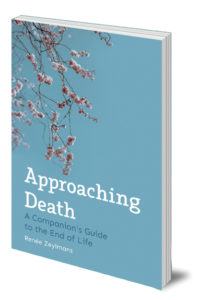Approaching Death: A Companion’s Guide to the End of Life
by Floris Books • 8 January 2020 • Holistic Health • 0 Comments

In “Approaching Death” experienced therapist and grief counsellor Renée Zeylmans offers spiritual insights, practical information and contemplations and meditations to support the companions of those on their dying journey. Here, we share an extract from the book.
From Caregiver to Companion
Being a companion of a dying person means that I feel the distress, suffering and joy of the other as if it were my own. Then a bridge is built within me that we can stand on together.
The ability to be a companion does not begin at the deathbed, but in daily life, and it has everything to do with the way we interact with our fellow human beings. For how can we be a support for a dying person if we have not, at least to some extent, acquired the approach of a companion in daily life? It is also related to the way we ourselves handle crisis, grief and joy in life. For doesn’t every change, every crisis we go through, carry death and resurrection in itself?

Dying people find themselves in the greatest crisis of their life, a crisis that comes with confusing and violent emotions, and is greater than they can probably put into words themselves. As a caregiver, you are deeply involved in this crisis.
In such situations it is important that you have the courage to practise self-reflection every time, for you inevitably also go through a process, no matter how experienced you are. If you don’t want to do this, or don’t have the courage to face yourself, it is good to make that conscious, for it always influences your behaviour and actions in relation to the dying. They hear in the sound of your voice whether you are willing to carry them inwardly and are ready for the confrontation. What counts is that you truly connect with them. This is not a path of the head, but one of the heart. ‘Only with the heart can you see well,’ said the fox in The Little Prince by Antoine de Saint Exupéry. Actions performed merely out of a methodology or routine cannot remain hidden from the dying, for their consciousness is broader and more intuitive than ours.

In training we are often told to keep a distance, the so-called professional approach, and we are taught all kinds of methods for this. But are there still people who want this kind of caregiving? People today see right through those things. We want to meet a person with a loving, listening ear, in brief, a companion who walks with us on our way.
Martin Buber relates a story of the Hasidic Rabbi of Sasor who, when he saw someone suffer, had such compassion that he made that person’s suffering his own. When he was asked how that is possible, he replied: ‘What, com-passion? Isn’t that suffering-together-with? How can I do differently than make it my own?’ Dostoevsky speaks in all his works of this com-passion, this suffering-together-with the suffering of the other: ‘If we experience the brother creature in him, we can do no other.’

If we learn how to deal with our emotions, a mutual connection will grow, and sharing joys and sorrows will bestow life wisdom on us. Being a companion does not mean drowning in emotions, but discerning and accompanying the deeper layer of grief. Repressing feelings or hiding behind a professional attitude will lead sooner to burnout than if you face them and work them through. By practising such a professional attitude for a longer time you harm yourself, and this inevitably leads to exhaustion, sometimes only many years later.
Those dying also don’t ask us to pour our wisdom all over them. Assisting those dying means a closeness, but also a distance.

It frequently happens when you visit someone who has a chronic or terminal illness to comfort or help them, that after leaving you feel comforted or helped yourself. You notice then that these people have become so wise and mild in the course of their illness that they radiate something into the world. The inner struggle that they go through because of the illness is not lost when they die; they take it with them as strength through the gate of death. – Joop van Dam, physician
Let us make sure that a person in distress is not forced to listen to our grief and worries, so that those who need consolation, often radiating a kind of receptivity, do not in fact have to hear the troubles of someone else. This is a trap that we can also face in daily life; may I burden the other with my feelings that arise at the deathbed?

It does not mean that there can be no mutual exchange. You participate in the joys and sorrows of the dying person – a laugh and a tear. But what comes up in you needs to be weighed to determine whether it contributes something to the other. Holding back what came up in you is then borne with dignity, and you have to look for a way in yourself to work it through. You put it in a place where it can ripen, until the moment comes when it can bear fruit for the future. That is the gift of the dying. Not just trouble and pain, but also growth and blossoming.



